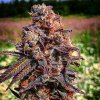Daub Marley
Active Member
Lowered nightime temps (behind genetics) are the most influential in purpling a plant. You're trying to mimic the natural seasonal progression though.
"When a number of warm, sunny autumn days and cool but not freezing nights come one after the other, it's going to be a good year for reds. In the daytime, the leaves can produce lots of sugar, but the cool night temperatures prevent the sugar sap from flowing through the leaf veins and down into the branches and trunk. Anthocyanins to the rescue! Researchers have found out that anthocyanins are produced as a form of protection. They allow the plant to recover nutrients in the leaves before they fall off. This helps make sure that the tree will be ready for the next growing season. Anthocyanins give leaves their bright, brilliant shades of red, purple and crimson" http://dnr.wi.gov/eek/veg/trees/treestruecolor.htm
"When a number of warm, sunny autumn days and cool but not freezing nights come one after the other, it's going to be a good year for reds. In the daytime, the leaves can produce lots of sugar, but the cool night temperatures prevent the sugar sap from flowing through the leaf veins and down into the branches and trunk. Anthocyanins to the rescue! Researchers have found out that anthocyanins are produced as a form of protection. They allow the plant to recover nutrients in the leaves before they fall off. This helps make sure that the tree will be ready for the next growing season. Anthocyanins give leaves their bright, brilliant shades of red, purple and crimson" http://dnr.wi.gov/eek/veg/trees/treestruecolor.htm











